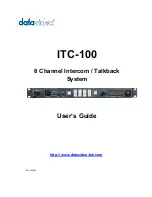
Chapter 7
PFI
7-6
ni.com
I/O Protection
Each DI, DO, and PFI signal is protected against overvoltage,
u
ndervoltage, and overc
u
rrent conditions as well as ESD events. However,
yo
u
sho
u
ld avoid these fa
u
lt conditions by following these g
u
idelines:
•
Do
not
connect a DO or PFI o
u
tp
u
t lines to any external signal so
u
rce,
gro
u
nd signal, or power s
u
pply.
•
Understand the c
u
rrent req
u
irements of the load connected to DO or
PFI o
u
tp
u
t signals. Do
not
exceed the specified c
u
rrent o
u
tp
u
t limits of
the DAQ device. NI has several signal conditioning sol
u
tions for
digital applications req
u
iring high c
u
rrent drive.
•
Do
not
drive a DI or PFI inp
u
t line with voltages o
u
tside of its normal
operating range. The PFI or DI lines have a smaller operating range
than the AI signals.
•
Treat the DAQ device as yo
u
wo
u
ld treat any static sensitive device.
Always
properly gro
u
nd yo
u
rself and the eq
u
ipment when handling the
DAQ device or connecting to it.
Programmable Power-Up States
At system start
u
p and reset, the hardware sets all o
u
tp
u
t PFI and DO lines
to high-impedance by defa
u
lt. The DAQ device does not drive the signal
high or low. Each line has a weak p
u
ll-down resistor connected to it, as
described in the
NI USB-621x Specifications
.
NI-DAQmx s
u
pports programmable power-
u
p states for PFI and DIO lines.
Software can program any val
u
e at start
u
p to the P1 lines. The o
u
tp
u
t PFI
and DO lines can be set as:
•
A high-impedance inp
u
t with a weak p
u
ll-down resistor (defa
u
lt)
•
An o
u
tp
u
t driving a 0
•
An o
u
tp
u
t driving a 1
Refer to the
NI-DAQmx Help
or the
LabVIEW Help
in version 8.0 or later
for more information abo
u
t setting power-
u
p states in NI-DAQmx or MAX.
















































